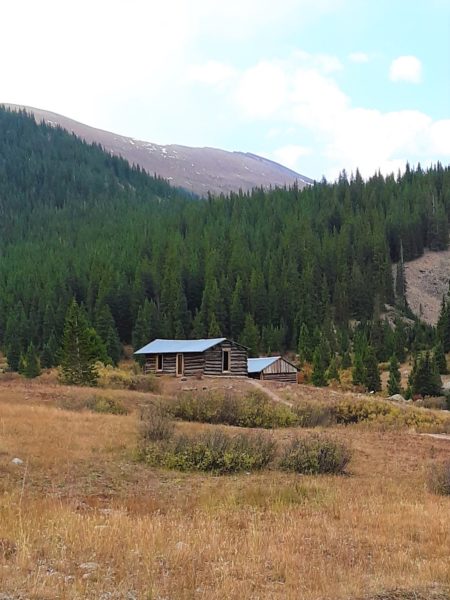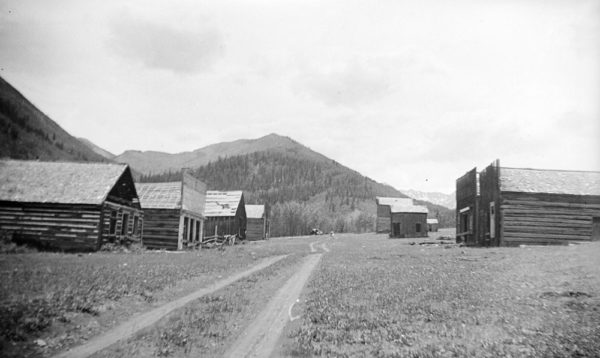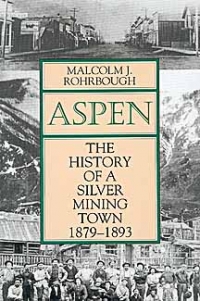
Located near Aspen, Colorado, are the ghost towns of Ashcroft and Independence, two fascinating reminders of the mining boom era in Colorado’s central mountains.
At 10,900 feet, the ghost town of Independence can be found along Highway 82 just west of Independence Pass, Colorado’s highest mountain pass. The town was given its name following a gold discovery on July 4, 1879. Although silver mining dominated the region, Independence was one of the few mining towns in the area associated with gold mining. In the early 1880s the town’s population grew to about 1,500, with about forty businesses. But within just a few years, the gold played out and miners moved to the more lucrative silver mines in and around Aspen. Harsh weather conditions also contributed to the town’s abandonment. By the early 1900s, it was a ghost town. Over the years, the weather took its toll on many of the buildings, and local residents became concerned for the preservation of the remaining structures. In 1973 the town was listed on the National Register of Historic Places, and in 1980 the Aspen Historical Society took control of preserving the site. A 2007 State Historical Fund grant further aided with the site’s preservation.
Another ghost town sits eleven miles from Aspen on Castle Creek Road. This is the abandoned silver mining town of Ashcroft. Originally a mining camp established in 1880, Ashcroft grew to a town of over 2,000 residents. It featured two newspapers, a hotel, a school, and as many as twenty saloons. For a short time, Ashcroft had more residents than nearby Aspen. But by late in the decade, Ashcroft was already losing population. A lack of railroad connections to the town, along with competition from nearby Aspen where several exciting new silver discoveries had been made, caused Ashcroft to decline. The 1893 repeal of the Sherman Silver Purchase Act, which devastated Colorado’s silver mining industry, spelled further doom for what was left of Ashcroft. The town’s post office closed in 1912. A few old-time miners stayed in the area, but by the 1930s, Ashcroft was a ghost town.
Around mid-century the growing ski industry revived interest in the old town, which was envisioned as part of a ski resort. These plans never materialized, and later landowners sought to preserve what remained of the town’s buildings. The land was eventually transferred to the U.S. Forest Service which leased the townsite to the Aspen Historical Society beginning in the 1970s. It was also added to the National Register of Historic Places. Today, the site is open to visitors who can explore the town’s nine remaining buildings.

Walking through ghost towns today, it’s hard to remember that these were once thriving places filled with people. Decades ago, Colorado Magazine published reminiscences of individuals who had spent time in both towns. Carroll H. Coberly came to Ashcroft in 1906, well after the town’s boom days but during a time when there was still mining activity in the area. His article “Ashcroft,” in the April 1960 issue, looks at life in the town as well as the nearby Montezuma-Tam o’ Shanter mines. Coberly also writes about the area’s natural beauty and its plants and animals. Since he did experience Ashcroft following its heyday, he also describes the town’s decline.
Offering a different perspective is Mrs. M. B. Hall, who lived briefly in Independence during its boom days. In “Experiences in Leadville and Independence, 1881-82,” in the March 1933 issue, she describes her travels from Kansas and Iowa to the mountains of Colorado with her husband, who took a job in the office of the stamp mill, and baby daughter. Hall’s descriptions of life in a muddy, floorless cabin with only a fireplace for cooking illustrate the challenges of living in a cold, remote, and dangerous mining camp. “Our cabin…door had been hewn out of a log, so thick that no bullets could go through it, which I appreciated, as there was much careless shooting going on.” Hall even describes the saloons, gambling, and “women from the underworld” she observed in the town. Her descriptions of stagecoach rides through the area are also paint an interesting picture of this fascinating time and place.
 Independence and Ashcroft wouldn’t have existed if not for the area’s mining activity. More about the mines associated with the towns can be found in the annual/biennial reports of the State Bureau of Mines, and in the publication The Natural Resources, Industrial Development, and Condition of Colorado, published by the State Bureau of Immigration and Statistics in 1889. For further reading, check out Aspen: History of a Silver Mining Town, available to borrow from State Publications through Prospector.
Independence and Ashcroft wouldn’t have existed if not for the area’s mining activity. More about the mines associated with the towns can be found in the annual/biennial reports of the State Bureau of Mines, and in the publication The Natural Resources, Industrial Development, and Condition of Colorado, published by the State Bureau of Immigration and Statistics in 1889. For further reading, check out Aspen: History of a Silver Mining Town, available to borrow from State Publications through Prospector.
- How to Spot the Differences Between Eagles and Hawks - August 16, 2021
- How Transportation Projects Help Tell the Story of Colorado’s Past - August 9, 2021
- Time Machine Tuesday: The Night the Castlewood Canyon Dam Gave Way - August 3, 2021